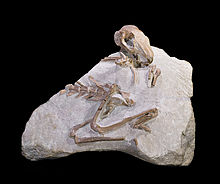Palaeolagus
| Palaeolagus | |
|---|---|

| |
| Palaeolagus haydeni | |
| Scientific classification | |
| Domain: | Eukaryota |
| Kingdom: | Animalia |
| Phylum: | Chordata |
| Class: | Mammalia |
| Order: | Lagomorpha |
| Genus: | †Palaeolagus Leidy, 1856 |
| Species | |
| |
Palaeolagus ('ancient hare') is an extinct genus of lagomorph.[2] Palaeolagus lived in the Eocene[3] and Oligocene epochs of North America,
Taxonomy[edit]
The fossil remains of rabbits are scanty and those specimens that have been found are often too fragmentary to determine satisfactory the relationship with living forms. Most recent phylogenetic analysis have recovered it as a close relative of the last common ancestor of living Leporidae and Ochotonidae, as it displays a mosaic of characters typical of both groups.[4] The bones of rabbits and hares are lightweight and fragile in structure, and so they are not easily preserved as fossils. Most of the species are inhabitants of uplands where conditions are not ideal for preservation. In a few deposits, rabbit remains seem numerous but many fossil species are known only from a few teeth and bones.
Description[edit]
The 25 centimetres (9.8 in) long creature closely resembled modern rabbits. They were common herbivorous inhabitants of the savanna, plains and woodlands of North America 30 million years ago.[citation needed]
Gallery[edit]
-
P. haydeni skull
-
Restoration of P. haydeni
References[edit]
- ^ Palmer, D., ed. (1999). The Marshall Illustrated Encyclopedia of Dinosaurs and Prehistoric Animals. London: Marshall Editions. p. 285. ISBN 1-84028-152-9.
- ^ Haaramo, Mikko (2008-03-11). "Mikko's Phylogeny archive". Retrieved 2009-02-01.
- ^ "Fossilworks: Gateway to the Paleobiology Database".
- ^ Wolniewicz, Andrzej S.; Fostowicz-Frelik, Łucja (2021). "CT-Informed Skull Osteology of Palaeolagus haydeni (Mammalia: Lagomorpha) and Its Bearing on the Reconstruction of the Early Lagomorph Body Plan". Frontiers in Ecology and Evolution. 9. doi:10.3389/fevo.2021.634757. ISSN 2296-701X.




